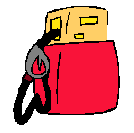MTBE (Methyl tertiary-butyl ether)
The gasoline additive MTBE has been used since 1979 as a gasoline oxygenate to help gasoline burn cleaner. It was in MTBE is a persistent pollutant that can remain in groundwater for many years. The EPA's recommended limit is 20 to 40 parts per billion, but some states have set lower limits. MTBE is not classified as a human carcinogen at low exposure levels, but exposure to large doses of MTBE carries significant non-cancer-related health risks. The effects of the prolonged presence of this alcohol derivative are not fully understood. Treatment: MTBE is best removed from water by Activated Carbon, and coconut shell carbon is the preferred carbon. In most cases coconut shell carbon has a 2.5 times higher capacity for MTBE removal the bituminous carbon. Even so, sufficient contact time is essential for effective removal. A 12 x 30 or 12 X 40 mesh size is normally used, and this supports a flow rate of about 1 gpm. Higher rates are possible with 20 X 50 mesh coconut shell, but pressure drop increases dramatically. For drinking water, many carbon block filters effectively reduce MTBE at a flow rate of 0.5 to 0.9 gmp. |
|
|
|
 wide usage as a substitute for lead in the 1990s until the realization that it was contaminating groundwater in many areas of the US led to its use being banned or severely restricted. It has now been replaced largely by ethanol.
wide usage as a substitute for lead in the 1990s until the realization that it was contaminating groundwater in many areas of the US led to its use being banned or severely restricted. It has now been replaced largely by ethanol.